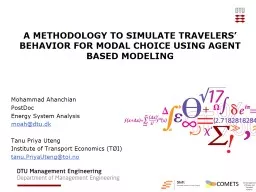

Mohammad Ahanchian PostDoc Energy System Analysis moahdtudk Tanu Priya Uteng Institute of Transport Economics TØI tanuPriyaUtengtoino Main avenues for decarbonization of inland ID: 816073
Download The PPT/PDF document "A METHODOLOGY TO SIMULATE TRAVELERS’ B..." is the property of its rightful owner. Permission is granted to download and print the materials on this web site for personal, non-commercial use only, and to display it on your personal computer provided you do not modify the materials and that you retain all copyright notices contained in the materials. By downloading content from our website, you accept the terms of this agreement.
Slide1
A METHODOLOGY TO SIMULATE TRAVELERS’ BEHAVIOR FOR MODAL CHOICE USING AGENT BASED MODELING
Mohammad AhanchianPostDocEnergy System Analysismoah@dtu.dkTanu Priya UtengInstitute of Transport Economics (TØI)tanu.PriyaUteng@toi.no
Slide2Main avenues for decarbonization of inland transport
2
Slide3What is modal shift
cost, time, level
of service or reliability
3
Slide4Dimensions of different modes
Travel Time
Travel Budget
4
Slide5Agent
Based Modeling in Modal ShiftTravelers are regarded as agents.Agents don’t have interaction with each other. In TU Survey, there is no data about how people make decision. However, there are the historical data that how people
accomplished the trip.Make decision according to decision rules in
the traffic
system
.
AnyLogic
tool
using
JAVA
programming.
5
Slide6Layers of this
study
6
Slide7Data gathering and model structure
7
Slide8Generate random agents (Monte Carlo)
8
Slide9Monte Carlo Simulation
The Monte Carlo simulation will replicate 30 times in both approaches to show the robustness of the model
9
Slide10Assign the attributes of responders to Agents
Individual Level
Family Level
Trip
10
Slide11Decision making algorithm on mode of transport
The decision
rules
are
based
on
Tangible
and
intangible
costs
Availibility
of
infrastructure
Access to
bike
/car
Based on these rules, the agents
decide
on Mode of Transport
11
Slide12Non-Motorized (NMT)
VoT
(DKK/Min) from LTM
varies
across
trip purpose (
e.g
., business vs.
other
purposes) and
household
income
.
12
Slide13Private car
The choice of private car as a driver is conditional on having a driver’s license and car. Furthermore, the choice of private car as a passenger is conditional on having a car.
CongestionTime
extracted
from LTM and
changes
across
zones
Penalty
parameters
are
extracted
from LTM and
change
across
trip purpose
FDM (2017). Billigere at køre efter rundstykker.
13
Slide14Total
Cost
Individual
n will choose alternative
i
*
if and only if
:
Public
14
Slide15Calibration
15
Slide16Results (BAU)
The results will predict commuter travel behavior and transportation system utilization in response to changes in fuel/ticket price, infrastructure (waiting/Acc/Egress time).
16
Slide17THANK YOU FOR YOUR ATTENTIONQuestions
? Comments!moah@dtu.dktanu.PriyaUteng@toi.no
17